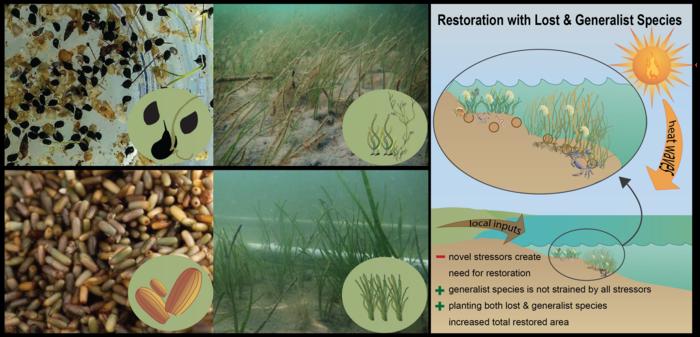New research demonstrates that seagrass habitat restoration can be enhanced by including other grasses in addition to the declining or lost species and – ultimately – that restoration efforts must proactively select species that can withstand current and intensifying stressors driven by human activities and climate change.

Credit: Credit: Enie Hensel, UMCES ian symbols, Virginia Institute of Marine Science.
New research demonstrates that seagrass habitat restoration can be enhanced by including other grasses in addition to the declining or lost species and – ultimately – that restoration efforts must proactively select species that can withstand current and intensifying stressors driven by human activities and climate change.
Rising global temperatures combined with centuries of humans working within our seascapes has reshaped coastal ecosystems. Rebuilding or restoring coastal habitat is becoming a top priority for natural resource conservation and as an insurance policy for the provision of critical services including shoreline protection, clean water, and seafood. Yet, successful habitat restoration is still rare, and most efforts are unsustainably expensive and labor intensive.
“Any gardener knows the difficultly in mastering how to grow a plant from seed or a clipping, and the same goes for restoration practitioners using habitat-forming species – discovering the perfect conditions.” says Enie Hensel, lead-author, postdoctoral researcher at UF IFAS SWES Nature Coast Biological Station and former postdoctoral researcher at William & Mary’s Virginia Institute of Marine Science (VIMS).
Seagrasses are experiencing global declines and, in the Chesapeake Bay, United States, where this study was conducted, intensifying heat waves are a main cause for declines in the dominant seagrass, eelgrass (Zostera marina). Recent research has shown the most successful restorations span large areas and location selection is key. The location should have a certain sand or sediment type, water quality level, temperature range, and the presence of beneficial ‘bugs’ or invertebrates that graze off grass-smothering algae – all of which are dependent on grass identity (M. M can Katwijk et al., 2016).
“These novel environmental conditions are a challenge for restoration. But what tends to always thrive in someone’s yard, no matter how hard one caters to their prized lawn grass, are weeds. And this fact might translate well to seagrass restoration – incorporating ‘weedy,’ or generalist, seagrass species that aren’t necessarily the targeted species for a given restoration,” says Enie.
“This project is important because Chesapeake Bay eelgrass has been declining for the past 30 years due to warming waters and we need to start thinking about alternative restoration strategies that accommodate this shifting environmental baseline. Here, we included a widely distributed generalist seagrass, widgeongrass [Ruppia maritima], which increases the portfolio of species diversity, providing some insurance that helps enhance long term restoration success.” says co-author Christopher J. Patrick, co-lead of the Submerged Aquatic Vegetation Restoration portion of the U.S. Army Corps of Engineer’s Lynnhaven River Basin Ecosystem Restoration Project and director of the Chesapeake Bay’s SAV Monitoring and Restoration Program
For this study, Enie and her collaborators leveraged a planned seagrass restoration in the lower Chesapeake Bay and conducted a field experiment to evaluate (1) which seeding methods yielded the most widgeongrass growth, tested if seeding widgeongrass next to eelgrass can increase restoration success, and quantified how either seagrass species changes restored bed structure, invertebrate communities, and nitrogen cycling. In the following year, researchers operationalized their experimental findings during a multi-acre pilot restoration.
“This is the first large-scale restoration effort in the lower Chesapeake Bay to use widgeongrass, and one of the few field experiments to identify how to best grow widgeongrass in the wild,” Enie says.
In the experiment, hand-seeded widgeongrass successfully grew. The highest survival and growth were when seeding mimicked nature and for this study that meant seeding widgeongrass in the fall with no pre-seed treatment – an advantageous finding for practitioners as it requires the least effort. Additionally, by seeding both widgeongrass and eelgrass, the restoration nearly doubled in size as widgeongrass was seeded in the shallows where water temperatures were above local practitioners’ recommendation for eelgrass restorations.
“Two exciting findings: these young widgeongrass beds were, one, full of epiphytic algal grazers, the ‘beneficials’ for a seagrass meadow and two, recycled less nitrogen than its surrounding sandy substrate. While this trend will likely change as widgeongrass matures, young widgeongrass recycling a negligible amount of nitrogen in a nutrient-rich area should have a positive effect on both grasses by not further increasing available nutrients, a known seagrass stressor in human-influenced systems like the Virgina Beach area” says Enie.
This study was a part of the initial phase for SAV Restoration led and supported by William G. Reay of the Chesapeake Bay National Estuarine Research Reserve (NOAA NOS/OCM, NA21NOS4200127) at VIMS as well as Robert J. Orth and Christopher J. Patrick of VIMS (NSF OCE 1737258 and 1658135) for the ‘Lynnhaven River Basin Ecosystem Restoration Project’ led and funded by the U.S. Army Corps of Engineers with local Norfolk District USACE (W912HZ-20-2-0021) as well as collaboration with City of Virginia Beach Department of Defense.
Journal
Journal of Applied Ecology
DOI
10.1111/1365-2664.14643
Method of Research
Experimental study
Subject of Research
Not applicable
Article Title
Incorporating generalist seagrasses enhances habitat restoration in a changing environment
Article Publication Date
30-Apr-2024




